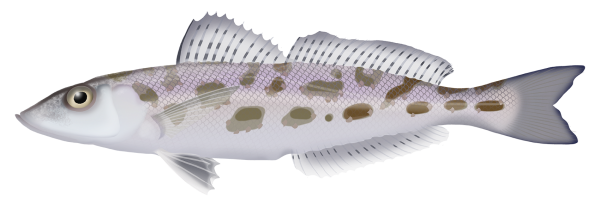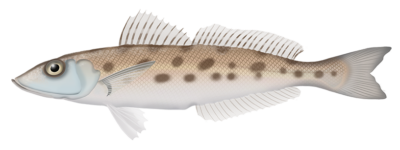Quick Facts
Distribution

Interesting Info
- Western Trumpeter Whiting is primarily found in the coastal waters of Western Australia, ranging from the Shark Bay region in the north to the South-West region, including Perth and Albany. They are also found in the Northern Territory and around Queensland down to Mackay.
- Their body coloration varies, but they generally have a silvery hue with pale to yellowish undersides. The upper parts of their body can be marked with irregular dark bands or blotches, and they possess a dark spot at the base of their pectoral fin.
- They are a carnivorous fish species that primarily feeds on small invertebrates, worms, and crustaceans, utilising their protractile mouth and excellent vision to forage in sandy or muddy substrates.
- They are a schooling fish, often forming large schools, particularly during their juvenile stages, which provides them with protection against predators and enhances their chances of successful foraging.
- Western Trumpeter Whiting are capable of undertaking long-distance migrations between different coastal areas. These movements are influenced by factors such as food availability, temperature, and reproductive needs.
- The coloration of Western Trumpeter Whiting can vary based on their surroundings. They have the ability to change their body color to match the substrate they are in, providing them with camouflage and protection from predators.
- Breeding habits of Western Trumpeter Whiting are closely tied to their spawning season, which occurs primarily during the spring and early summer months (September to December) along the Western Australian coastline.
- Male Western Trumpeter Whiting build nest-like depressions in sandy or muddy substrates near the shore, where they court females and lay their eggs. The males guard the eggs until they hatch, which usually takes around one week.
- Their estimated average lifespan is between 5 – 7 years.
Species Interaction
Recreational Fishing, Snorkeling & Diving
Western Trumpeter Whiting are not considered a primary target for recreational anglers. However, they are often caught incidentally by anglers targeting other species. They are commonly caught from beaches, jetties, and small boats near the shore. Their abundance in nearshore areas makes them accessible to recreational fishers with basic equipment. Snorkelers and divers can easily observe them in the wild, as they often swim in shallow waters close to the shoreline.
Scientific Classification
Kingdom: Animalia
Phylum: Chordata
Class: Actinopterygii
Order: Perciformes
Family: Sillaginidae
Genus: Sillago
Species: Sillago Burrus
Conservation Status
In terms of conservation status in Australia, the Western Trumpeter Whiting is considered a species of Least Concern. While it does face some localised threats, such as habitat degradation and overfishing, its overall population remains stable.
Fish Taste Quality
Western Trumpeter Whiting are known for its delicate and flavourful white flesh, making it a desirable fish to eat.
Taste Rating: 4/5
How to catch
Western Trumpeter Whiting
Catch Difficulty: Intermediate
Tackle: Running Sinker Rig, Artificial Rig
Bait: Crab, Fresh cut flesh baits, Lures, Prawns, Shellfish, Squid, Worms, Yabbies, Soft plastics
Technique: Keep bait on the bottom, Cast bait/jig/lure near schooling fish
Popularity: Targeted
Recreational Viewing
- Snorkeling & Scuba
Finding: Easy
Temperament: Peaceful
Location: Inner Reef, Seagrass Beds, Sandflats
Danger: None





